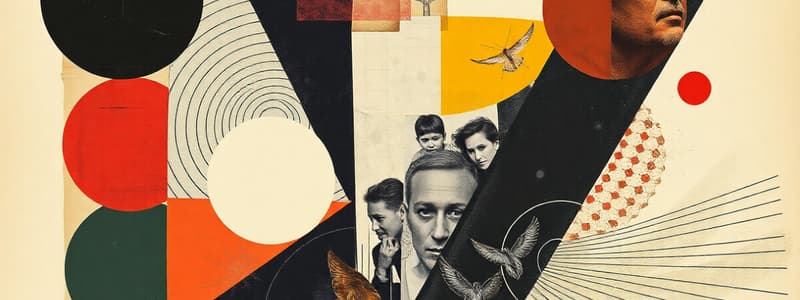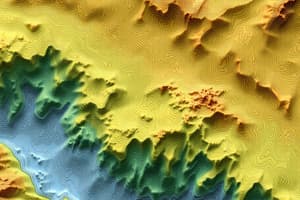Podcast
Questions and Answers
Which type of line is most associated with conveying a sense of rest and quietness?
Which type of line is most associated with conveying a sense of rest and quietness?
- Horizontal (correct)
- Diagonal
- Curved
- Vertical
What distinguishes implied lines from contour lines in a visual artwork?
What distinguishes implied lines from contour lines in a visual artwork?
- Contour lines are always straight, while implied lines are curved.
- Contour lines define the edges of shapes, while implied lines are suggested by a series of points connected visually. (correct)
- Implied lines are three-dimensional, whereas contour lines are two-dimensional.
- Implied lines define the edges of shapes, while contour lines are suggested by the viewer's perception.
In the context of two-dimensional art, what is the term for the area that represents the subject of the artwork?
In the context of two-dimensional art, what is the term for the area that represents the subject of the artwork?
- Ground
- Figure (correct)
- Negative space
- Positive space
Which technique uses the relative positions of objects in a picture plane to create the illusion of depth?
Which technique uses the relative positions of objects in a picture plane to create the illusion of depth?
What is the main effect of atmospheric perspective on objects as they recede into the distance?
What is the main effect of atmospheric perspective on objects as they recede into the distance?
Which property of color refers to its lightness or darkness?
Which property of color refers to its lightness or darkness?
What happens to a color when more colors are mixed into it, according to the pigment wheel theory?
What happens to a color when more colors are mixed into it, according to the pigment wheel theory?
Which color scheme involves using different shades and tints of a single color?
Which color scheme involves using different shades and tints of a single color?
Which principle of art refers to the distribution of visual weight within a work?
Which principle of art refers to the distribution of visual weight within a work?
What distinguishes asymmetrical balance from symmetrical balance in art?
What distinguishes asymmetrical balance from symmetrical balance in art?
In art, what is the role of 'movement' as a principle?
In art, what is the role of 'movement' as a principle?
What is a 'motif' in the context of pattern in art?
What is a 'motif' in the context of pattern in art?
What is the primary distinction between artists and artisans?
What is the primary distinction between artists and artisans?
Which art movement is Vincent Willem Van Gogh associated with?
Which art movement is Vincent Willem Van Gogh associated with?
Which Filipino artist is known as the 'Grand Old Man of Philippine Art'?
Which Filipino artist is known as the 'Grand Old Man of Philippine Art'?
Eduardo Mutuc, a Filipino artisan, specializes in what craft?
Eduardo Mutuc, a Filipino artisan, specializes in what craft?
What is the primary characteristic of Surrealism as an art style?
What is the primary characteristic of Surrealism as an art style?
What is the focus of Conceptualism in contemporary art?
What is the focus of Conceptualism in contemporary art?
Which art style relies on painting tiny, distinct dots next to one another to form an image?
Which art style relies on painting tiny, distinct dots next to one another to form an image?
Which art movement, developed during the 1860-1970 era, signifies a philosophical style?
Which art movement, developed during the 1860-1970 era, signifies a philosophical style?
Flashcards
Line
Line
An infinite series of points arranged in a direction, either straight or curved.
Contour Lines
Contour Lines
Lines that define the outer edges and shapes of objects.
Implied Lines
Implied Lines
A series of points connected by the viewer's eye; not explicitly drawn.
Shape
Shape
Signup and view all the flashcards
Form (Mass)
Form (Mass)
Signup and view all the flashcards
Space
Space
Signup and view all the flashcards
Positive Space (Figure)
Positive Space (Figure)
Signup and view all the flashcards
Negative Space (Ground)
Negative Space (Ground)
Signup and view all the flashcards
Overlapping
Overlapping
Signup and view all the flashcards
Shading
Shading
Signup and view all the flashcards
Linear Perspective
Linear Perspective
Signup and view all the flashcards
Foreshortening
Foreshortening
Signup and view all the flashcards
Atmospheric Perspective
Atmospheric Perspective
Signup and view all the flashcards
Texture
Texture
Signup and view all the flashcards
Value
Value
Signup and view all the flashcards
Hue
Hue
Signup and view all the flashcards
Saturation
Saturation
Signup and view all the flashcards
Complementary colors
Complementary colors
Signup and view all the flashcards
Movement
Movement
Signup and view all the flashcards
Unity
Unity
Signup and view all the flashcards
Study Notes
Elements of Art
- A line is an infinite series of points arranged in a direction and can be straight or curved
Types of Lines
- Horizontal lines evoke rest, quietness, relaxation, and contemplation
- Vertical lines are pointed, balanced, forceful, and dynamic
- Diagonal lines suggest action
- Curves display action, life, and energy, lacking harshness
- Contour lines define an object's edges
- Implied lines are a series of points connected by the viewer's perception
Shape
- Shape is an area of two-dimensional space, having length and width
- Geometric shapes are mathematical
- Organic shapes are found in nature
Form
- Form (or mass) is three-dimensional, possessing volume (length, width, and height)
Space
- Space refers to the area around, between, and within shapes or forms
- Positive space is occupied by a figure
- Negative space is the surrounding ground
- In 2-dimensional art, the positive space is the figure, while the negative space is the ground
Illusion of Space
- Overlapping creates a sense of depth by placing one object in front of another
- Size indicates distance, with larger objects appearing closer and smaller objects farther away
- Placement affects perceived distance; objects higher in the picture plane seem further away
- Shading uses light and dark colors to create a 3D effect
Linear Perspective
- Linear perspective makes objects appear smaller as they recede into the distance, using lines
- One-point perspective involves all parts receding toward a single vanishing point
- Foreshortening adjusts the size and shape of objects to create the illusion of depth and perspective
Atmospheric Perspective
- Atmospheric perspective makes objects look hazy and less detailed as they get farther away
- Foreground is the area closest to the viewer
- Middle ground is the area between the foreground and background
- Background is the area farthest from the viewer
Texture
- Texture is the tactile quality of a surface
- Actual texture can be physically felt
- Simulated texture appears to have texture but is smooth
Value
- Value measures lightness or darkness
Color
- Color is how we perceive light encompassing properties
Three Main Properties of Color
- Hue is the color name
- Saturation is the intensity or vibrancy of the hue
- Value is the lightness or darkness of a color
Color Types
- Primary colors consist of red, blue, and yellow
- Secondary colors are green (blue + yellow), violet (blue + red), and orange (red + yellow)
- Tertiary colors include red-violet and blue-green
Color Mixing
- Pigment wheel: mixing more colors results in a darker, less bright color
- Additive color systems: adding more colors of light results in a brighter color
Color Temperatures
- Warm colors evoke heat
- Cool colors evoke coldness
Color Relationships
- Complementary colors are opposite each other on the color wheel
- Monochromatic uses different shades and tints of one color
- Analogous uses colors next to each other on the color wheel
Time
- Time in art relates to duration or sequence, showing how artwork changes or how events tell a story
Principles of Art
- Unity is the feeling that all parts of an artwork belong together
- Variety is the use of different elements of art
- Proportion is the relationship between the sizes of different parts of a work of art
Balance
- Balance is the distribution of visual weight in a work of art
- Symmetrical (bilateral) balance is when both sides of the artwork are mirror images of each other
- Radial balance is like a starfish, radiating from a central point
- Asymmetrical balance is when the visual weight is balanced but not identical on both sides
- Contrast is the arrangement of opposing elements
Emphasis
- Emphasis draws attention to a specific part of an artwork, creating a focal point
Movement
- Movement guides the viewer's eyes through the picture, often using a curvy line or path of colors
Rhythm
- Rhythm involves repeating shapes or colors in a painting to create a visual rhythm
Pattern
- Pattern is a repeated design, that gives the painting structure
- Motif is the repeated part of a pattern
- Types of patterns - Regular and Irregular
Artists vs Artisans
- Artists focus on creating aesthetically pleasing works
- Artisans focus on accessorizing and functionality
Visual Artists
- Leonardo Da Vinci created art during the Renaissance
- Vincent Willem Van Gogh worked in the style of Impressionism
- Michelangelo created art during the Renaissance
- Claude Monet was an Impressionist painter
- Pablo Picasso was an abstract artist
- Edward Munch worked in the style of Expressionism
Filipino Visual Artists
- Fernando Amorsolo was the first National Artist and known as the 'Grand Old Man of Philippine Art'
- His works are displayed at The Vargas Museum
- Ang Kiukok was a National Artist in 2001
- Juan Luna was an artist
- Felix Hidalgo was an inspiration for members of the Philippine reform movement
- Vicente Manansala was a National Artist in 1982
- Carlos “Botong” Francisco was the best mural artist
Filipino Artisans
- Lang Dulay was a T’Boli artisan
- Magdalena Gamayo was an Ilocano artisan
- Eduardo Mutuc was a metalsmith
- Teofilo Garcia was a casque maker
- Yabing Masalon Dulo was an Ikat Weaver
Modern and Contemporary Art
- Modern art encompasses artworks produced during the 1860-1970 era
- Realism is a style of art developed
- Surrealism captures subjects from the world of dreams, imaginations, and fantasies
- Impressionism is a style of art developed
Art styles
- Pointillism involves painting tiny dots next to one another to form an image
- pioneered by Georges Seurat and Paul Signac in Paris in the mid-1880s
- Fauvism uses strong and bright colors
- Cubism was led by Paul Cezanne, the Father of Cubism
- Futurism relates to the future
- Virticism focused on the innovative advances of the machine age
- Constructivism uses simple geometric shapes and forms
- Suprematism was led by Kazimir Malevich
- De Stijl (Dutch for “The Style”) features strict geometry of horizontals and verticals
- Dada/Dadaism reacted against WW2
Contemporary Art
- Contemporary art is work made between 1970 and the present
- Pop Art includes popular and mass culture
- Photorealism is a style of art developed
- Conceptualism emphasizes ideas and concepts over traditional techniques
- Performance art is a style of art developed
- Installation Art is a style of art developed
- Earth Art transforms natural environments
- Street Art is a style of art developed
Studying That Suits You
Use AI to generate personalized quizzes and flashcards to suit your learning preferences.




